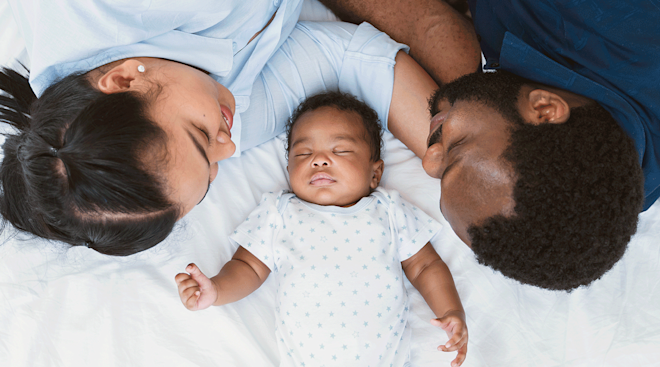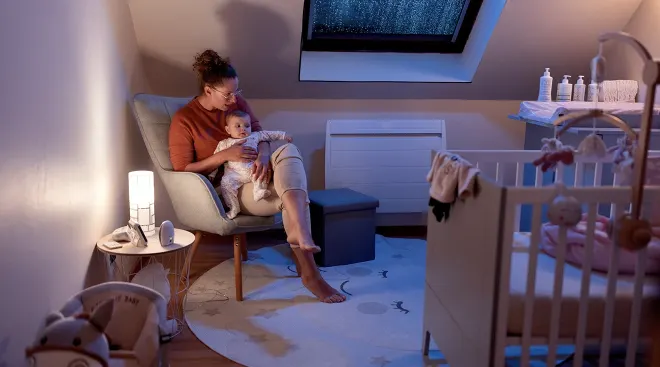6 Pro Tips for How to Get Baby to Nap Longer
It’s every parent’s favorite time of day: Nap time! (That is, if all goes smoothly.) Getting baby to take solid naps throughout the day is not only important for their physical and mental development, but it also plays a key role in promoting good sleep at night. Not to mention, it’s also the time of day that many parents count on in order to get things done!
But if you’ve tried and tried to get baby to take good naps without success, you’re not alone. Short and inconsistent naps are a common struggle that I see among babies under age one, and there are several reasons why this might be happening with your child. Here’s what might be going on, and how to get baby to nap longer—for both your sake’s!
Most parents are eager to learn how to get baby to nap longer—but an endless amount of sleep isn’t what’s best for little ones. Let’s start with the recommended totals of daytime sleep that we like to see based on baby’s age, so you have an idea of what you’re actually aiming for.
For babies 0-3 months
In the newborn stage, baby is sleeping a lot (even if it doesn’t seem like it). The total amount of sleep your infant should be getting in a 24-hour period is between 14 and 17 hours, and four to six of those hours should be dedicated to sleep during the day. Just remember, naps will be very inconsistent in this stage, and that’s normal!
For babies 3.5-6 months
Once your child has graduated from the newborn stage, naps will start to consolidate a bit better. The goal is for baby to be napping about three to five hours per day, usually broken up between three to four naps.
For babies 7-9 months
As your little one starts to gradually work toward two naps, their nap totals will decrease slightly to about two and a half to four hours. I recommend hanging on to that third nap until baby is about 8 or 9 months old or until it’s very clear the third nap is no longer needed.
For babies 10-14 months
Once baby is solidly on a two-nap schedule, you may notice that as they get older, their day sleep needs decrease slightly, and naps may become slightly shorter. This is nothing to panic about, but you still want to make sure baby is sleeping between two and a half to three and half hours during the day across two naps.
So what if your child isn’t taking long enough naps to get the recommended amount of sleep for their age? The key to understanding how to get baby to nap longer is figuring out what’s preventing them from snoozing for long stretches in the first place. There are several reasons that babies struggle to get adequate day sleep, many of which are not as obvious as you might think. Here are a few of the sneaky but common culprits.
1. Your child is overtired
If you misjudge baby’s awake window—meaning the amount of time your child is able to stay awake, depending on their stage of development—and put baby down for a nap too late, your child will be overtired. While it might sound counterintuitive, being overtired actually makes it harder for baby to fall asleep, leading to a nap time struggle and likely a short or missed nap.
What to do: For the first year of life, follow awake windows to determine when baby should be sleeping, and look for sleepy cues to ensure you’re not missing your child’s nap window.
2. Baby has outgrown their nap schedule
In some cases, the secret to how to get baby to take longer naps is making sure they’re actually tired. Your child may need longer awake windows to have time to build up more sleep pressure in between naps.
What to do: Make sure your child’s nap schedule is age-appropriate, and adjust as needed. Here are my recommendations for a child’s nap schedule by age.
3. Baby wakes up after one sleep cycle
An infant’s sleep cycle lasts approximately 30 to 45 minutes, and at the end of it they’re in REM sleep, which is a lighter stage of sleep. While it’s normal for babies to wake up in between sleep cycles, there are some factors that may prevent them from being able to fall back asleep on their own. They might need help replacing a pacifier that’s fallen out, for example, or they simply might need help self-soothing.
What to do: If you notice baby waking promptly at the end of a sleep cycle, help them go back to sleep by replacing any lost pacifiers, rubbing their head, stroking their back, shushing them or rocking them. If your child can self-soothe, they may not need you, but most babies will need some help getting back to sleep—and that’s okay! While you can help baby practice independent sleep skills at this stage, if they’re struggling, it isn’t something you want to force.
4. Baby’s sleep environment isn’t promoting sleep
If your child is napping in the car or stroller instead of in a consistent sleep environment—aka their crib or bassinet—they aren’t going to get the best quality of sleep. To get baby to nap longer, you’ll need to adjust where they’re sleeping.
What to do: Follow the 80/20 rule. Some car and on-the-go naps are inevitable, but aim for the majority of naps (at least 80 percent) to be in their own sleep space, whether it’s their crib or bassinet. Use white noise and blackout shades to ensure that baby isn’t waking up due to external factors such as noise or daylight sneaking in.
5. Your child is stuck in an overtired cycle
There are several reasons baby might be stuck in an overtired and overstimulated cycle, leading to poor naps and nighttime sleep.
What to do: To break baby of this cycle, you need to make sure your child’s awake windows aren’t too long and that they’re getting adequate night sleep. In some cases you may need to perform an “assisted nap,” which is essentially holding or wearing baby (depending on their age) in order to elongate their nap and break the overtired cycle.
But wait, didn’t I just tell you to set a consistent sleep environment in a crib? Yes, and this is only meant as a temporary solution until you break the overtired cycle. It doesn’t work for all babies, but it can work wonders if done correctly. In order to do an assisted nap safely, hold or wear your little one while you’re sitting in a rocking chair (or standing, if wearing) and place baby in a position that’s safe and ensures that their airways are open. It’s important to note that this should never be done while you’re on the verge of falling asleep yourself.
6. Baby is waking early from a nap due to hunger
If your child’s feeding schedule doesn’t align with their nap schedule, or baby isn’t getting full feedings throughout the day, they may wake from a nap looking for a feed.
What to do: The goal for the first year of life is to aim for full feeds: about 4 to 5.5 ounces every two and a half to three hours. Try your best to time feedings during awake periods so baby is nice and full before each nap and isn’t missing a feeding. If you’re nursing or feeding on demand, you may want to think about implementing more structure in your child’s feeding routine to ensure they’re getting full feeds instead of snacking.
Short naps can be frustrating for both you and baby, and it can take a bit of troubleshooting to determine the culprit and figure out how to get baby to nap longer. Once you address each of the areas above, you’re sure to see longer naps in a matter of weeks, leading to better sleep for baby and more time for you!
Rachel Mitchell is a maternity and pediatric sleep specialist, founder of My Sweet Sleeper and mom of six. She has been working with families all over the world for nearly 10 years, helping them implement practical tips and approaches with their children to help them get better sleep. My Sweet Sleeper offers online classes, one-on-one sessions, e-guides and helpful content through social channels and blogs. If you need 1:1 assistance, please contact Mitchell here.
Please note: The Bump and the materials and information it contains are not intended to, and do not constitute, medical or other health advice or diagnosis and should not be used as such. You should always consult with a qualified physician or health professional about your specific circumstances.
Plus, more from The Bump:
Navigate forward to interact with the calendar and select a date. Press the question mark key to get the keyboard shortcuts for changing dates.




















































